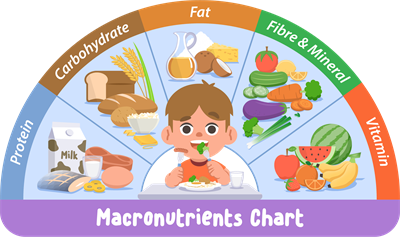Let’s learn: understanding nutrients in English lets you unlock the secrets to better energy and peak performance in sports or school. Plus, it gives you the power to decode food labels and impress your friends with your healthy eating knowledge! Let's learn new words.

Read, listen, and learn!
nutrient — [ˈnjuː.tri.ənt] — any substance that humans, plants or animals need to live and grow; uzturviela
A balanced diet provides all the essential nutrients your body needs to function properly.
protein — [ˈprəʊ.tiːn] — one of the many substances found in food such as meat, cheese, fish, or eggs, that is necessary for the body to grow and be strong; olbaltumviela, proteīns
This dish is high in protein.
carbohydrate — [ˌkɑː.bəʊˈhaɪ.dreɪt] — one of several substances, such as sugar or starch, that provide the body with energy, or foods containing these substances such as bread, potatoes, pasta, and rice; ogļhidrāts
Your body turns carbohydrates into energy you can use immediately.
fat — [fæt] — the substance under the skin of humans and animals that stores energy and keeps them warm; tauki
Healthy fats, like those in nuts and avocados, are good for your brain and heart.
fibre — [ˈfaɪ.bər] — the part of foods eaten that is not digested but that passes through the body and is excreted as waste; šķiedrviela
Pay attention:
fiber — American English
fibre — British English
Foods high in fibre, like fruits and whole grains, can help you feel full longer.
vitamin — [ˈvɪt.ə.mɪn] — any of a group of natural substances that are necessary in small amounts for the growth and good health of the body; vitamīns
Your body needs different vitamins to keep your eyes, skin, and energy levels in good shape.
mineral — [ˈmɪn.ər.əl] — a chemical that your body needs to stay healthy; minerālviela
Minerals help your body perform vital functions, like keeping your heart beating.
Let’s revise: “a rice” or “rice”? “A cookie” or “cookies”? Food can be countable or uncountable in the English language. You learned this in form 4. Take a look and revise:
The Use of "Much," "Many," "A lot of"
Let’s revise: to remember this grammar topic better, do some exercises:
Let’s revise: to remember this grammar topic better, do some exercises:
Let’s learn: you know that “much”, “many”, and “a lot of” are used to express large amounts. But how to express small amounts?
Watch the video and find out how to use “a few” and “a little” correctly.
Watch the video and find out how to use “a few” and “a little” correctly.
ESL grammar – quantifiers – a few vs a little
“A few” is used with plural countable nouns.
“A little” is used with plural uncountable nouns.
Example: Add a little milk to your tea. (“Milk” is a plural uncountable noun)
Svarīgi!
Remember: “a few” and “a little” mean “some.”
“A few” is used with plural countable nouns.
Example: I need a few oranges. (“Oranges” is a plural countable noun)
“A little” is used with plural uncountable nouns.
Example: Add a little milk to your tea. (“Milk” is a plural uncountable noun)